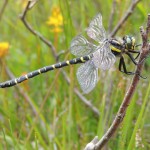MAMMALS
Bank Voles in Howe Park Wood (HA)
Roe deer by the North Bucks Way (7th May – HA)
Roe Deer – Shenley Wood (6th)
Badger seen at Linford Lakes (5th – MK)
BIRDS
Garden Warblers singing in Howe Park Wood and Tattenhoe Park (HA)

Garden Warbler, Tattenhoe Park (5th May) (HA)
Reed Warblers around Furzton Lake, Tattenhoe Park and North Bucks Way (HA)
Swifts over Tattenhoe and Furzton (HA)
Pair of Spotted Flycatchers by brook in Furzton (4th May – HA)
Hobby over Tattenhoe Park (5th May – HA)
Cuckoo, 2 Barn Owls, 2 Hobbies – Linford Lakes (5th – MK)
8 Red Kites at Newton Longville (8th – MK)
Goosander with 9 young at Olney Mill
Turnstone at Manor Farm (5th)
Spotted Flycatchers at Shenley Wood and Linford Lakes
LEPIDOSAURIA (aka “REPTILES”)
9 Grass Snakes found at Walton Lake (4th – MK/Ella Cooke)
2 Grass Snakes basking outside Near Hide, Linford Lakes (7th)
Adder skin found at Rammamere Heath (2nd – Helen Wilson)
INSECTS
Lepidoptera
Holly Blue and Large White butterflies around Furzton and Tattenhoe (HA)

Holly Blue, Howe Park Wood (6th May) HA
Green-Veined Whites and Orange Tips in most parts of Tattenhoe (HA)
Red Admirals in and around Howe Park Wood (HA)
Dingy Skipper and Small heath butterflies at Blue Lagoon (8th – MK)
4 Red Admirals on North Bucks Way (8th – MK)
Pair of Orange-Tips in copula – Blakelands (15th May, Steve Brady)
Coleoptera
Great Diving Beetles in ponds at Linford Lakes (5th – MK)
Hymenoptera
Red Mason bee, Ashy mining bee, Hairy Footed Flower Bee all nesting in walls at Manor Farm Court, Old Wolverton (6th – MK)
Odonata
Large Red and Azure Damselflies emerging around Howe Park Wood ponds and Tattenhoe Park (HA)
Hairy Dragonflies around Tattenhoe Linear Park and Howe Park Wood ponds (HA)

Female Hairy Dragonfly, Tattenhoe Linear Park (6th May) HA
Four-Spotted Chaser in Tattenhoe Linear Park (6th May) (HA)
Homoptera
Black and Red Froghoppers in Tattenhoe Park (HA)
FLOWERS
Water Crowfoot in ponds at Woughton on the Green.
Early Purple Orchids in most woodlands.
Herb Paris in flower in Linford Wood
Field Poppies out along grid roads
Sightings reported by HA = Harry Appleyard, MK = Martin Kincaid, or as named
*Sightings cover the past 10 days, unless indicated by individual dates*
Natural England and the Centre for Ecology & Hydrology (CEH) have launched a new online database and analytical tool called Pantheon, which helps us better understand conservation status and habitat-related traits of invertebrates.



 Butterfly Conservation have produced a collection of species factsheets and habitat downloads can be used to provide an overview on species ecology, assist with species identification and advise on best practice management for specific species and habitats.
Butterfly Conservation have produced a collection of species factsheets and habitat downloads can be used to provide an overview on species ecology, assist with species identification and advise on best practice management for specific species and habitats.
 iRecord Butterflies is a free app that will guide you through the identification of any butterfly that you see in the UK and allow you to add your sighting to millions of other valuable records that inform the work of Butterfly Conservation.
iRecord Butterflies is a free app that will guide you through the identification of any butterfly that you see in the UK and allow you to add your sighting to millions of other valuable records that inform the work of Butterfly Conservation.























































































































 [HA]
[HA]






















































